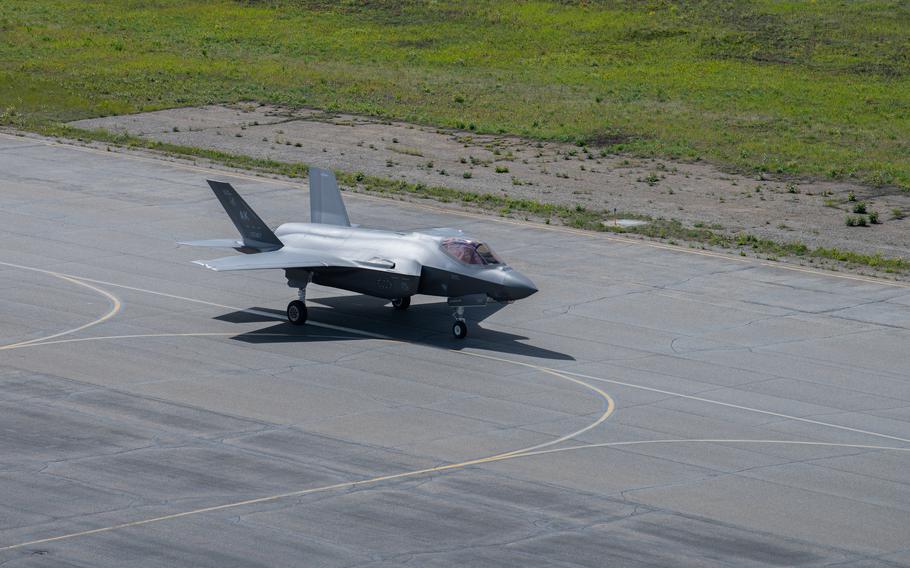Opinion
F-35 Lightning II can rise above criticism, deliver for US, allies as envisioned
Special to Stars and Stripes July 5, 2023

A U.S. Air Force F-35 Lightning II with the 356th Fighter Squadron taxis to the runway during Red Flag-Alaska 2023 at Eielson Air Force Base, Alaska, June 13, 2023. There are about 1,000 of the aircraft operated by the U.S. and its closest allies. (Cedrique Oldaker/U.S. Air Force)
History is replete with examples of human achievement that had profound impacts on world events. Fire, the wheel, the printing press, the compass, the light bulb, transistors, the telegraph and antibiotics are prime examples, with more recent instances including the internet, GPS and Space X’s Starlink.
In the military world, the U.S. Constitution clearly states that national defense is the priority job of the national government. So, which systems have created similar transformations within our military? Early advances in small arms and then heavy firepower, in armored ships, submarines, airpower, radar and other electronic systems, guided missiles, nuclear weapons and unmanned platforms have all been transformative.
A comparatively revolutionary capability is now emerging, following years of constant criticism and stark negative headlines, to underpin the first major shift in global alliances since the end of World War II. This shift is driven by three major factors.
First is the melting of the Arctic and the opening of strategic sea lanes, eliminating the historic geographical boundaries once protected by the ice. The second is the Russian invasion of Ukraine and its potential to reignite a world war. The third is Chinese expansionist tensions and the potential conflict with Taiwan.
More than 20 years ago, a new venture began to develop a common platform to support joint combat. Conceived from the beginning as a multiservice, multinational replacement for 10 legacy military aircraft, the F-35 Lightning II’s variants support the very different operational environments of three combatant services: Air Force, Navy and Marine Corps. Eight of our closest allies shared its development costs.
This new platform was intended to integrate the latest technologies of stealth, highly integrated sensors and data-sharing systems. It would serve as a node in a network sharing information with other platforms in the air, land, sea and space. By replacing the logistic and repair chain of those 10 older aircraft, it would reduce overall acquisition and ownership costs.
More importantly, all the partner forces and nations would be able to fly and fight as a unified, interoperable force, leveraging their individual national investments.
There are about 1,000 F-35s operating across all three of those U.S. services and a significant number of our closest allies. Every nation surrounding the Arctic is a current or future F-35 operator. Canada, the Netherlands, Denmark, Norway, Finland, Switzerland, Germany and Belgium are all F-35 partners. With the pending accession of Sweden, this new circum-Arctic alliance will most likely be the next evolution of NATO.
In the Pacific, F-35 primary partner Australia is joined by Japan, South Korea and Singapore. The Pacific theater differs from that of Northern Europe. Huge sea distances separate the partners, but when supported by U.S. supercarrier task forces deployed to the region, a consolidated allied strategic force comes into existence. Thus, this single aircraft is acting to preserve stability in both of the most fiercely contested regions of our world.
Often criticized during its development as too costly, the Lightning II is thus having a subtle, yet pervasive impact on a global scale. The F-35 has gone through multiple international competitions. It has never lost a competition based on cost.
While it has taken more than 20 years to get to this point and the gestation has been rocky at times, it’s time the general public understood the positive strategic impact these new alliances will have. They will strengthen both the United States and our global allies, and promote the causes, ultimately, of democracy and peace.
Some inventions, as mentioned above, have changed the world. The F-35 is fast becoming one of them.
Tom Burbage and Betsy Clark are coauthors with Adrian Pitman and David Poyer of “F-35: The Inside Story of the Lightning II.” Burbage was Lockheed Martin’s general manager of the F-35 program from 2000 to 2013. Clark is director of the Independent Project Review Institute in Canberra, Australia.